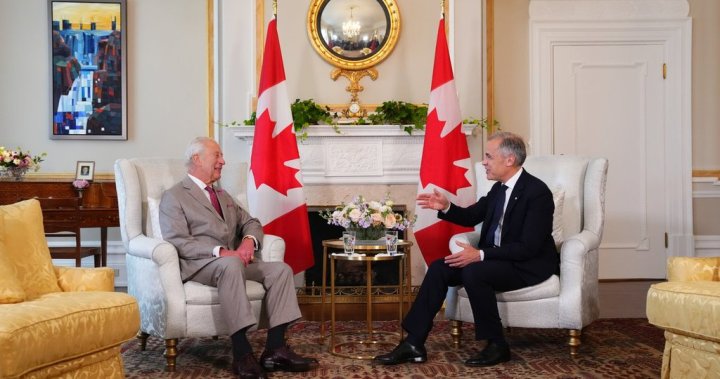King Charles III and Queen Camilla took their place in the Senate on Tuesday, following a procession through downtown Ottawa ahead of the King delivering the speech from the throne to outline Prime Minister Mark Carney‘s vision for the upcoming session.
Former prime ministers Kim Campbell, Stephen Harper and Justin Trudeau were in attendance, as well as the late former prime minister Brian Mulroney’s widow Mila Mulroney. Former governors general David Johnston and Michaelle Jean were also in the audience, as well as Supreme Court of Canada judges, Chief of the Defence Staff Gen. Jennie Carignan and former Speakers of the House of Commons including Geoff Reagan and Peter Milliken, and Manitoba Premier Wab Kinew, among other high-profile guests.
Carney’s throne speech is expected to focus on economic growth and trade, with the prime minister having outlined his goals for this session during a caucus meeting Sunday, with affordability a primary goal.
He told his expanded Liberal caucus that the government would also “fight to ensure that Canadians get the best relationship possible with the United States, and we will take the time to do so.”
The prime minister had also stressed that the government would be “very, very busy” in the coming weeks and months, promising “one of the most busy returns of Parliament in Canadian history.”

Get breaking National news
For news impacting Canada and around the world, sign up for breaking news alerts delivered directly to you when they happen.
Carney said his ministers will immediately introduce legislation to fast-track infrastructure projects deemed to be in the national interest and bring in a bill to eliminate all federal barriers to free trade in Canada.
The Liberals will need to get the support of members from at least one other party to pass the speech from the throne, which is considered a confidence test and could bring down the government if enough MPs vote against the implementing legislation.
However, with a Liberal caucus of 168 MPs — Speaker Francis Scarpaleggia was elected as a Liberal but must remain impartial and only votes in the event of a tie — the Conservatives, Bloc Québécois and NDP would all have to vote against the government to defeat it in a confidence motion.
Even if Green Party MP Elizabeth May voted against the government and the NDP were to abstain, it would not be enough votes.
The Conservatives have signalled they would help the Liberals as much as possible on the U.S. trade and security issue, though have promised to press the government on keeping its word on expanding energy projects and lowering taxes.
The King’s delivery of the speech is expected to be watched not only for its content, but also for the historic nature of the moment.
The last time a monarch delivered the speech from the throne in Canada was in 1977.
The speech is normally delivered by the governor general — the monarch’s representative in Canada — but after the federal election, Carney announced the King would be delivering that speech.
On Monday, before the King’s arrival, Carney said it “matches the weight of our times.”
It comes at a time when U.S. President Donald Trump has repeatedly threatened Canada’s sovereignty by saying the country should be the 51st state.
The vote on the speech will likely not happen right away, but once presented normally gets about six days of debate.
— with files from Global News’ Sean Boynton
© 2025 Global News, a division of Corus Entertainment Inc.
Read the full article here

